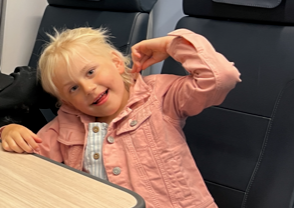Six-year-old Sienna is a feisty, confident, outgoing girl. Her mum, Mel, says that’s partly down to her diagnosis of neuroblastoma at an early age. “At just 18 months old, she had to explain how she was feeling, to describe the pain she felt,” says Mel, “and – like me – she’s had to learn to be resilient and tough during years of treatment and uncertainty.”
Sienna is one of four siblings and twin to Arianna. Following the latest lockdown, the girls have just started school together – Arianna waiting six months until her sister recovered from major surgery on her spine. With big brothers Archie and Alfie off school too during lockdown, and her partner a frontline worker with his own business, Mel was busy to say the least. But compared with what she’d been through since Sienna’s diagnosis in 2017, Mel says she found lockdown “a doddle”. Sienna’s condition was stable, she was on a treatment regime that had begun to shrink the tumour, and her pain was controlled by morphine. Although her prognosis was still uncertain, Mel felt for the first time in four years that there was hope.
Sienna’s tumour was misdiagnosed as an abscess initially, but Mel felt something more serious was wrong. She fought for an MRI when the ultrasound scan showed nothing. In hindsight, the first scan couldn’t locate the tumour because it was already too big. Now it measures 15cm by 14cm – the size of a large grapefruit.
Mel describes the diagnosis as “horrendously traumatic”, not least because Sienna’s case was classed as high risk due to her age, the size of the tumour, and the fact that it had already spread to another area. “All that went through my mind was death,” recalls Mel. “The medics described the worst case scenario and dispatched us in an ambulance to Great Ormond Street Hospital for emergency chemo. The treatment in the ambulance was outstanding, but I still have flashbacks about that journey now, nearly five years on.”
Still reeling from the shock and worried about her other three children whom she’d left with a neighbour while her parents came as quickly as they could, Mel was sick in the ambulance as it sped through London towards the hospital.
“The staff at Great Ormond Street were brilliant. They were all trained in counselling and always checked my partner and I were doing OK whenever we left Sienna’s room. They even sent us out to dinner with a baby monitor. I remember thinking – “we haven’t been able to go out to dinner for ages” – and thinking it was weird and surreal that here we were, in a restaurant behind Great Ormond Street, our first dinner out just the two of us for such a long time.”
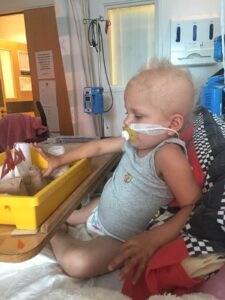
After a five-day stay, Sienna was discharged to the John Radcliffe Hospital to continue her treatment. But the chemo made no impact on the tumour.
“Next they tried an eight-week course of high intensity chemo,” says Mel, “they explained to us she was likely to become very poorly from the side effects, to the point where they had to measure her waist before beginning the treatment so they could check whether it was causing her liver to expand. But literally nothing happened. No side effects to the extent expected – and no change to the tumour.”
Specialists enrolled Sienna in a trial at Southampton University, which would mean a 10-day stay in another London hospital, radiation, no contact with anyone for 15 days following the treatment. Anything she’d had contact with would have to be incinerated. Mel wrote to the makers of Sienna’s most-prized possession “rabbit” – and asked whether they could send supplies. “They sent loads and we spent ages trying to make them look suitably matted so as to pass as the original rabbit,” recalls Mel. Mel herself would only be allowed to see Sienna through a glass barrier after this treatment, and as the family prepared for this horrific ordeal, more uncertainty and upheaval came their way. “They told us the tumour was too close to Sienna’s spine and the risk of paralysis was too high.” The treatment was cancelled – and Mel had to make houseroom for all the rabbits that Sienna had fallen in love with.
But there was some light on the horizon. In November 2019, Sienna began a trial at the Royal Marsden Hospital with a new drug. For the first year, she had to attend the Royal Marsden for treatment three days a week. “Now we’re 18 months in and we can do what’s needed from home, which makes such a difference,” says Mel. “No-one knows how long she might need to stay on the drug – or how long she can stay on it – it’s all so new. But the last two scans showed some positive signs – the tumour had shrunk by 15% at her last scan in May.”
In the meantime, Sienna had undergone emergency surgery on her spine. “Last summer, she suddenly couldn’t walk,” explains Mel. “We always knew the tumour could paralyse her, and we thought perhaps it had hit the spinal cord.”
Scans showed that pressure on the spine had caused two vertebrae to fuse together. “The surgery itself carried a 90% risk of paralysis,” says Mel, “so we’d decided we wouldn’t go down that route until absolutely necessary.”
Sienna’s surgery was a success, and by Christmas she was walking again, with metal rods supporting her spine. “Those 12 weeks were hard,” says Mel, “three months during lockdown that she spent on the floor of our lounge.”
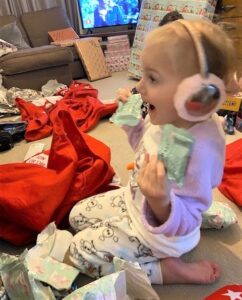
It was physically tiring for Mel to lift Sienna and so her brother came every other weekend to help out. “He was part of our bubble but he was worried about travelling when restrictions came into place. It was great to have the Rennie Grove nurses on hand to reassure us it was allowed.”
Mel says the Rennie Grove Children’s Nurses gave her peace of mind and practical support in other ways too. “It was great knowing I could call at any time just to talk or to ask advice.” Sometimes, says Mel, that was as simple as needing contact details for a physio. At others she might have more in-depth frustrations, questions or concerns about treatment that she could share and discuss with the nurses.
“Of course it’s tiring looking after four kids,” she admits, ”but the worry that comes with caring for a child with serious health needs – the sense of responsibility when you’re overseeing their care in any setting – is draining.”
For Mel, having specialist nurses at the end of a phone to share that responsibility has been a huge relief. “Although lockdown’s been relatively easy for us, hospital visits during the pandemic have been really tough. Being the only adult allowed to accompany your child – you really feel the full weight of that responsibility.”
Mel explains it’s not just the obvious challenge of being alone in a stressful situation, but also the consequences of that on family life. “My partner says he finds it harder to understand Sienna’s condition now because he doesn’t get the direct insight from the hospital visits.”
Mel didn’t take up the offer of respite care from Rennie Grove ”because I felt guilty about leaving all four kids or going somewhere with three of them and leaving Sienna!” she admits. “But the charity’s Play Specialist came to visit us recently which was lovely. They all did colouring while I did some housework.”
Although Mel faces new challenges as the children grow older and ask more questions about Sienna’s condition, she feels more hopeful about the future as the nation emerges from isolation.
“Sienna’s been isolated for more than half her life – sometimes stuck in one room for weeks on end. I feel more relaxed in myself now she’s living a more ‘normal’ life, at school, with her friends and with one-to-one support.”
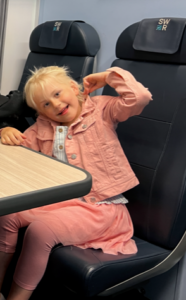
Where to next?
-
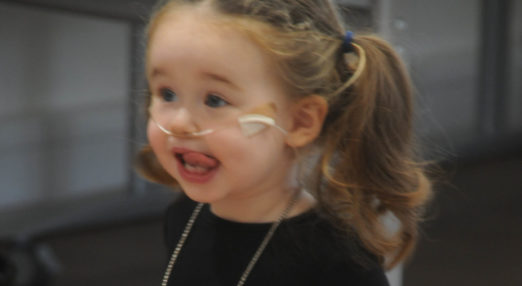
Support for children with life-limiting conditions
A whole-family approach to help families live the best quality life they can.
Read more
-
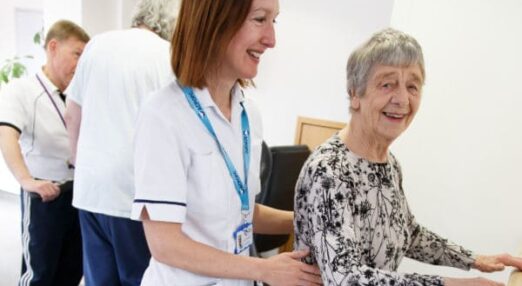
Share your story
Sharing the experience of the support you have received helps brings our work to life, inspiring our supporters and reassuring those in need of care.
Read more
-
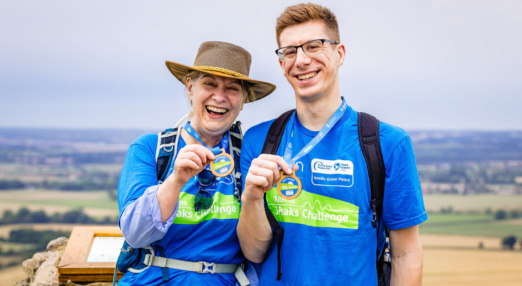
Get involved
Donate, fundraise, volunteer or shop with us to make a difference to local families facing life-limiting illness.
Read more

